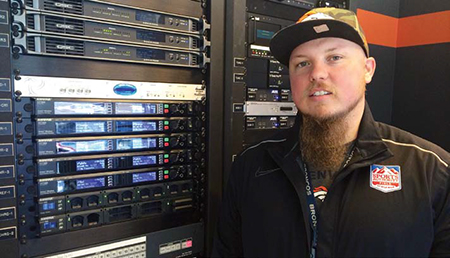The Challenge of Wireless Mic Coordination

Jeremy Wecker, manager of audio visual technology and engineering for Sports Authority Field at Mile High, home of the Denver Broncos
NEW YORK—Advances in audio quality and the desire to eliminate cables where-ever possible have led to an explosion in wireless microphone usage. It’s also forced broadcasters to take steps to ensure that frequency collisions are avoided.
Networks that televise major sporting events—and the crews that service them—are among the most severely taxed. NFL games, for example, shown to both regional and national audiences, require technical staffs whose sole job is to manage bandwidth of the wireless equipment (microphones in particular) that are critical to mission success.
“Our job is to coordinate every wireless device in the stadium, to make sure that everyone has a place to operate,” said Ralph Beaver, manager of NFL Game Day Coordination. The networks supply Beaver’s team with a list of 25 microphones, for example, that will be employed, but they’re not required to detail the exact usage. Packages include a blend of surround, parabolic, and talent microphones, each with its own frequency requirements. At least two members of Beaver’s crew are present at every game the league broadcasts, and they’re charged with making sure that no collisions occur.
KEEPING BAD RF OUT CP
Communications, an Elmsford, N.Y.- based provider of audio and video communications gear, supplies wireless equipment for every NFL game. For Sunday games, CPC receives a list of frequencies that will be available by Tuesday or Wednesday. Although some new audio systems are “sweepable,” a lot of the equipment—particularly audio gear that uses high quality filtering—is band specific. CPC prefers wireless microphones made by Sennheiser and other manufacturers for this reason, in certain applications.
“If you go totally wide band,” said Michael Mason, president of CPC, “the receivers often have a tough time discerning what is good RF—the signal from the wanted transmitter— and bad RF, the signals from surrounding transmitters, or even just the RF noise floor.”
Each region in the country has its own RF footprint and the packages that CPC sends out need to be modified for every location. Networks supply the trucks; CPC sends out technicians for the larger events, including Monday and Thursday night broadcasts. Regional games are handled by outside technicians, and CPC has to know the equipment that each team favors. “It’s all about providing the right tool for the set of technicians,” Mason said.
Get the TV Tech Newsletter
The professional video industry's #1 source for news, trends and product and tech information. Sign up below.
Outside crews must interface with each team’s own audio and video personnel. Jeremy Wecker, manager of audio visual technology and engineering for Sports Authority Field at Mile High in Denver, supervises a crew that manages all of the RF gear at the home of the Denver Broncos. He works with an NFL game day coordinator each week, who is responsible for managing the database for the league and allocating frequencies to all entities operating within the stadium to minimize the possibility that a frequency collision could occur. They also enforce the rules for noncompliance.
PREVENTING SQUATTERS
The biggest problem, according to Wecker, comes from non-compliant users stepping on previously allocated frequencies, as well as overall RF saturation in the building. Jam-ups can take place when two in-house devices are dialed into the same frequency, but they can also happen when a wireless device is tuned into the same frequency as a nearby outside device.
Technology like the Shure’s Axient Wireless Management Network have made life easier for his crew, Wecker said. Previously, wireless microphones were hard programmed; if interference compromised a device, a member of the Broncos crew would have to go on to the field to replace it. Running up to a referee who just made a critical call that no one can hear and handing him a new microphone is not exactly ideal television. The Axient system migrates frequencies automatically, eliminating this requirement. If necessary, the user can reprogram the device remotely, but Wecker said he’s never had to make that adjustment.
“For safety purposes we run in dual mode,” he said. “You can’t take a chance that the singer’s mic will go down, even for a moment, during the national anthem, for example. In dual mode, if Channel A gets interference, the system will immediately switch to Channel B and you won’t hear a glitch.”
As the federal government reassigns more frequencies to other users, broadcasters are having to deal with fewer channels, which means that large-scale programming in particular, including NFL games, has to be carefully managed.
Wired bandwidth is preferable because of the shortage of RF spectrum. The audio quality of wired mics is superior as well—particularly if bandwidth is tight— but the obvious advantages of wireless microphones make them the preferred choice for crews and talent. On any given Sunday, Ralph Beaver’s team may be managing up to 350 channels per game, and you can bump that up to more than 5,000 on the day of the Super Bowl.
Each of the coordinators has a spectrum analyzer that takes snapshots continuously, and a database from the FCC to help manage the flow. Their job is not unlike that of an air traffic controller: Keep every device in its own lane.
